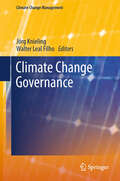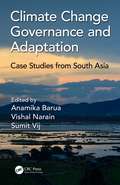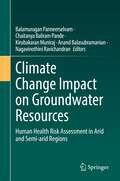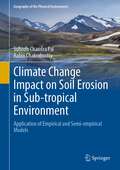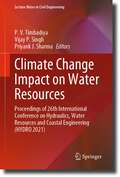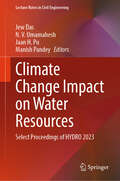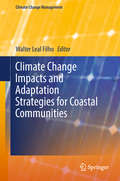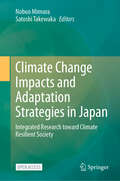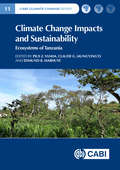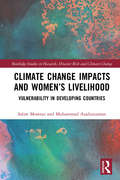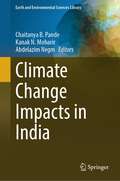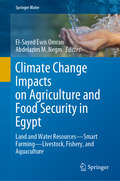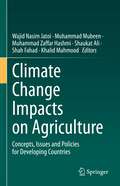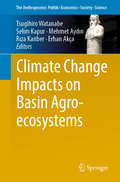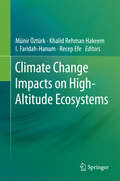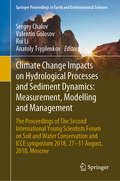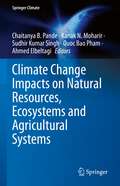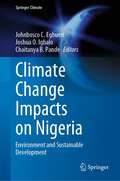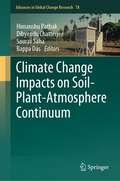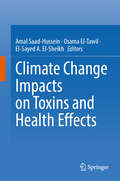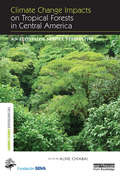- Table View
- List View
Climate Change Geoengineering
by Wil C. G. Burns Andrew L. StraussThe international community is not taking the action necessary to avert dangerous increases in greenhouse gases. Facing a potentially bleak future, the question that confronts humanity is whether the best of bad alternatives may be to counter global warming through human-engineered climate interventions. In this book, eleven prominent authorities on climate change consider the legal, policy, and philosophical issues presented by geoengineering. The book asks: When, if ever, are decisions to embark on potentially risky climate modification projects justified? If such decisions can be justified, in a world without a central governing authority, who should authorize such projects and by what moral and legal right? If states or private actors undertake geoengineering ventures absent the blessing of the international community, what recourse do the rest of us have?
Climate Change Governance (Climate Change Management)
by Walter Leal Filho Jörg KnielingClimate change is a cause for concern both globally and locally. In order for it to be tackled holistically, its governance is an important topic needing scientific and practical consideration. Climate change governance is an emerging area, and one which is closely related to state and public administrative systems and the behaviour of private actors, including the business sector, as well as the civil society and non-governmental organisations. Questions of climate change governance deal both with mitigation and adaptation whilst at the same time trying to devise effective ways of managing the consequences of these measures across the different sectors. Many books have been produced on general matters related to climate change, such as climate modelling, temperature variations, sea level rise, but, to date, very few publications have addressed the political, economic and social elements of climate change and their links with governance. This book will address this gap. Furthermore, a particular feature of this book is that it not only presents different perspectives on climate change governance, but it also introduces theoretical approaches and brings these together with practical examples which show how main principles may be implemented in practice.
Climate Change Governance and Adaptation: Case Studies from South Asia
by Anamika Barua, Vishal Narain and Sumit VijClimate change adaptation in South Asia is redefining the roles of different actors in the governance processes. The existing governance lack capacity, knowledge, and leadership skills to manage the uncertainties and challenges posed by climate change. This book aims to explain how the governance of climate change adaptation and mitigation is being shaped in the region and how climate change is impacting upon the governance of natural resources. Although the focus is on South Asia, the editors draw a wide range of contributions from northern and southern communities and across various agro-ecological contexts. Climate Change Governance and Adaptation: Case Studies from South Asia sees the changing climate not only as an environmental problem but as a societal challenge and discusses the governance challenges from an interdisciplinary social science perspective across different levels: local, state, and national. Discusses also the challenges and opportunities for increasing the resilience of the society through effective governance around climate change. A top down approach to govern climate change adaptation may not yield desired outcomes; instead the book emphasizes the need to integrate issues of equity, into climate governance and polices. The lessons learned from different cases across South Asia help readers have a better and deeper understanding of the relationships between governance and climate change. Given the diversity of themes covered, this book will appeal not only to researchers and practitioners in the climate change community, but also to those with a broader interest in governance processes.
Climate Change Impact on Groundwater Resources: Human Health Risk Assessment in Arid and Semi-arid Regions
by Chaitanya Baliram Pande Balamurugan Panneerselvam Kirubakaran Muniraj Anand Balasubramanian Nagavinothini RavichandranThis volume discusses climate change impacts on groundwater quality in arid and semi-arid regions, and provides human health risk assessments due to pollution of surface and groundwater. The book presents recent trends in monitoring groundwater management and implementing pollution mitigation strategies, including practices involving remote sensing and GIS techniques, entropy water quality index, weighted arithmetic water quality index, fuzzy logic applications, and improved irrigation methods. The book also outlines hydrological processes in arid and semi-arid regions and hydrochemical properties of surface and groundwater as a necessary background for understanding how pollution impacts groundwater quality and resources, and how geographical modeling of hydrological processes can aid in human health risk assessments. The book is intended for academics, administrators, policymakers, social scientists, and professionals involved in the various aspects of climate change impact on groundwater quality, hydrological process, pollution mitigation strategies, sustainable development, and environmental planning and management.
Climate Change Impact on Soil Erosion in Sub-tropical Environment: Application of Empirical and Semi-empirical Models (Geography of the Physical Environment)
by Subodh Chandra Pal Rabin ChakraborttyThis work focuses on the potential impact of climate change on soil erosion in a monsoon-dominated sub-tropical region. Water-induced soil erosion due to extreme rainfall during the monsoon period is a major problem worldwide, from different environmental and socio-economic perspectives. This study region covered (South Bengal) is one of the fertile agricultural belts that produces a good amount of produce and contributes to the country's GDP. However, the rate of agricultural output has decreased rapidly in recent times due to a decline in soil fertility. The monsoon-dominated sub-tropical region has unique characteristics in terms of seasonal temperature fluctuations and the availability of rainfall events. The sub-tropical region is densely populated, with the majority of the population relying on rain-fed agricultural production systems. The declining rate of agricultural production has also established that soil fertility is declining and soil erosion is increasing. Numerous studies show that soil erosion is the major cause of the region's rapidly increasing trend of land degradation. A homeostatic mechanism cannot replace soil erosion, and a gap arises between soil erosion and regolith formation. Extreme changes in land use and land cover, population growth and the lacking support for traditional agricultural practices and management practices can accelerate the rate of soil erosion and its associated reservoir sedimentation in most countries of the tropical and sub-tropical environment. Quantitative information with maximum possible accuracy through validation regarding soil loss can be an essential part of the appropriate and sustainable soil and water conservation planning. The precise aspects of modern day management strategies are soil erosion susceptibility mapping using empirical and semi-empirical models in a GIS platform or the use of probability statistics. The main objective of this work is to propose the most suitable development strategies considering the amount of soil erosion for the present and future periods. Extensive field research has been done to identify the support practice factor that the local stakeholders adopt in this region.
Climate Change Impact on Water Resources: Proceedings of 26th International Conference on Hydraulics, Water Resources and Coastal Engineering (HYDRO 2021) (Lecture Notes in Civil Engineering #313)
by Vijay P. Singh P. V. Timbadiya Priyank J. SharmaThis book comprises the proceedings of the 26th International Conference on Hydraulics, Water Resources and Coastal Engineering (HYDRO 2021) focusing on broad spectrum of emerging opportunities and challenges on the impact of climate change on water resources. It covers a range of topics, including, but not limited to, climate change assessment and downscaling issues, climate change impact and adaptive measures, influence of climate variability on hydro-climatic variables, impact of climate change on water resources of Indian Rivers, etc. Presenting recent advances in the form of illustrations, tables, and text, the content offers readers insights for their own research. In addition, the book addresses fundamental concepts and studies on the impact of climate change on water resources, making it a valuable resource for both beginners and researchers wanting to further their understanding of hydraulics, water resources and coastal engineering.
Climate Change Impact on Water Resources: Select Proceedings of HYDRO 2023 (Lecture Notes in Civil Engineering #561)
by Manish Pandey Jaan H. Pu N. V. Umamahesh Jew DasThis book comprises the proceedings of the 28th International Conference on Hydraulics, Water Resources, River and Coastal Engineering (HYDRO 2023) focusing on broad spectrum of emerging opportunities and challenges on the impact of climate change on water resources. It covers a range of topics, including, but not limited to, climate change assessment and downscaling issues, climate change impact and adaptive measures, influence of climate variability on hydro-climatic variables, impact of climate change on water resources of Indian Rivers, etc. Presenting recent advances in the form of illustrations, tables, and text, the content offers readers insights for their own research. In addition, the book addresses fundamental concepts and studies on the impact of climate change on water resources, making it a valuable resource for both beginners and researchers wanting to further their understanding of hydraulics, water resources and coastal engineering.
Climate Change Impacts and Adaptation Strategies for Coastal Communities (Climate Change Management)
by Walter Leal FilhoThis book presents a comprehensive overview of research and projects regarding climate change adaptation in coastal areas, providing government and nongovernment bodies with a sound basis to promote climate change adaptation efforts. According to the 5th Assessment Report by the Intergovernmental Panel on Climate Change (IPCC), coastal zones are highly vulnerable to climate change, and climate-driven impacts may be further exacerbated by other human-induced pressures. Apart from sea-level rise, which poses a threat to both human well-being and property, extreme events such as cyclones and storm surges lead not only to significant damage to property and infrastructure, but also to salt water intrusion, groundwater salinisation, and intensified soil erosion, among many other problems. There are also numerous negative impacts on the natural environment and biodiversity, including damage to important wetlands and habitats that safeguard the overall ecological balance, and consequently the provision of ecosystem services and goods on which the livelihoods of millions of people depend. As such, there is a need for a better understanding of how climate change affects coastal areas and communities, and for the identification of processes, methods and tools that can help the countries and communities in coastal areas to adapt and become more resilient. It is against this background that this book has been produced. It includes papers written by scholars, social movements, practitioners and members of governmental agencies, pursuing research and/or executing climate change projects in coastal areas and working with coastal communities. Focusing on "managing climate change in coastal regions", it showcases valuable lessons learned from research and field projects and presents best practices to foster climate change adaptation in coastal areas and communities, which can be implemented elsewhere.
Climate Change Impacts and Adaptation Strategies in Japan: Integrated Research toward Climate Resilient Society
by Nobuo Mimura Satoshi TakewakaThis open access book presents the latest Japanese research for the projection of climate change impacts and the evaluation of adaptation policies, with a particular focus on the S-18 Project—a nationwide, interdisciplinary research initiative involving experts from various fields. Readers can get a comprehensive view of the latest knowledge and strategies to combat climate change impacts in Japan. The topics span the research framework and future scenarios for climatic and socio-economic changes, and impacts and adaptation measures in major sectors at both national and local levels. Target sectors include agriculture, forestry and fisheries, natural ecosystems, natural disasters and coastal zones, water resources, urban infrastructure, and transportation, quality of life and human health, and economic analysis of the impacts. The book features high-resolution spatial distribution of impacts, changes in vulnerability with localities, effects of mitigation and adaptation measures, and implications of climate change policies on society. As the world experiences increased extreme weather events, this comprehensive book is a timely reference for similar studies in other countries through the presentation of research results and lessons obtained in Japan. Researchers, policymakers, and academics in environmental science, climate policy, and related fields will find this book invaluable for understanding and addressing the multifaceted challenges of climate change adaptation and mitigation. Some chapters were written originally in Japanese. The English translation was facilitated by artificial intelligence. The authors later revised the content for accuracy.
Climate Change Impacts and Adaptation in Water Resources and Water Use Sectors: Case studies from Southeast Asia (Springer Water)
by Sangam ShresthaClimate change on earth is having significant impacts on water resources management in Southeast Asia. Knowledge of climate variations and climate change can be valuable for water resources management in agriculture, urban and industrial water supplies, hydroelectric power generation, and ecosystem maintenance. This book presents the findings of case studies on forecasting climate change and its impacts on water availability, irrigation water requirements, floods and droughts, reservoir inflows and hydropower generation, and crop yield in specific basins of Southeast Asian countries such as Thailand, Myanmar, and Vietnam. All case studies start by forecasting the climate change and investigating its impacts by employing several hydrological reservoir simulations and crop water requirement models. The findings provide sound and scientific advice for water managers on the real impacts of climate change and how to adapt to its many challenges.
Climate Change Impacts and Sustainability: Ecosystems of Tanzania (CABI Climate Change Series)
by Eugen Cyrilo Namkunda Johnson Richard J Katondo Godwin A Lema Emma T Liwenga N A Mbwambo Anselm R Mwajombe Patrick M Ndaki Agnes Ms Nyomora Noah M Pauline Florian Silangwa Kelvine C Shirima Pontian L Temba Adera Sisay Wassie Lucas E Yamat Josephine M ZimbaThis book provides a detailed analysis of the economic and environmental impacts of climate change on the tropical ecosystems in Tanzania. Topics covered include agriculture, marine resources, wildlife, and weather forecasting. The analyses concentrate on real and potential impacts of climate change, focusing on changes in temperature and precipitation. Adaptive capacity and strategies for enhancing resilience (such as changing crop types and crop patterns in farming) are described. Particular attention is paid to climate change impacts on vulnerability and resilience in communities and ecosystems with special reference to extreme events such as droughts and flooding. The book: is among the first books to analyse in detail climate change effects in Tanzania, highlighting the unique vulnerability of communities and ecosystems in East Africa from a socio-ecological point of view. discusses potential future threats as well as providing solutions to current problems. examines the application of local knowledge systems when formulating solutions. The book is essential reading for researchers on climate change and socio-economic impacts in tropical rural economies and of broad interest to climate change scientists, tropical ecologists, conservationists and agricultural scientists.
Climate Change Impacts and Women’s Livelihood: Vulnerability in Developing Countries (Routledge Studies in Hazards, Disaster Risk and Climate Change)
by Salim Momtaz Muhammad AsaduzzamanVery few studies have been conducted to explore the vulnerability of women in the context of climate change. This book addresses this absence by investigating the structure of women’s livelihoods and coping capacity in a disaster vulnerable coastal area of Bangladesh. The research findings suggest that the distribution of livelihood capitals of vulnerable women in rural Bangladesh is heavily influenced by several climatic events, such as cyclones, floods and seasonal droughts that periodically affect the region. Women face several challenges in their livelihoods, including vulnerability to their income, household assets, lives and health, food security, education, water sources, sanitation and transportation systems, because of ongoing climate change impacts. The findings have important policy relevance for all involved in disaster and risk management, both within Bangladesh and the developing countries facing climate change impacts. Based on the research findings, the book also provides recommendations to improving the livelihoods of women in the coastal communities. This book will appeal to academics, researchers and professionals in environmental management, gender and development, and climate change governance looking at the effects of and adaptation to climate change, gender issues and natural disaster management strategies.
Climate Change Impacts in India (Earth and Environmental Sciences Library)
by Abdelazim Negm Chaitanya B. Pande Kanak N. MoharirThis book focuses on the impact of climate change on India, addressing environmental problems and conducting an analysis of the climate change impact on mitigation processes. It examines crucial factors such as soil capability, soil erosion, soil salinity, and watershed planning, as well as the influence of climate change on water resources, including groundwater. The book explores the interconnections between climate change, soil erosion, natural resources, and agricultural practices, emphasizing their direct or indirect effects on water, vegetation, irrigation planning, and the environment.Furthermore, it delves into various aspects of soil erosion, soil compaction, soil nutrients, aquifers, and the impact of climate change on vegetation, crops, pests, moisture, and sustainable yield. These factors contribute to the development of climate change-related factors within the agricultural sector, ultimately fostering sustainable development and management practices for the future. The book also highlights the significance of parameters such as land use change analysis, rainfall, water resources, crop yield, sustainable agricultural development, pest management, and disease control in accurately assessing the impact of climate change. The insights gained from these analyses can inform future development and planning strategies. Therefore, this book serves as a valuable resource for researchers, scientists, NGOs, and academics interested in understanding the impact of climate change on natural resources and ecological systems.
Climate Change Impacts on Agriculture and Food Security in Egypt: Land and Water Resources—Smart Farming—Livestock, Fishery, and Aquaculture (Springer Water)
by Abdelazim M. Negm El-Sayed Ewis OmranThis book gathers contributions discussing climate change in Egypt from an agricultural perspective. Written by leading experts, it presents state-of-the-art insights and the latest research developments in light of the most recent IPCC report. Focusing on identifying the specific phenomena that affect climate change in Egypt, the book also addresses the effects of climate change in Egypt, particularly examining the quality and quantity of water resources as well as the socio-economic impacts of climate change on agricultural activities. Furthermore, it explores alternative solutions to support agriculture and food security and raises awareness of adaptation and protection as the key to adapting to the risks posed by climate change. Covering the four fundamental pillars of climate change: food security, availability, access and stability, this book is a valuable resource for stakeholders involved in achieving the 2030 sustainable development goals in Egypt and all countries with similar climatic conditions. It is also a unique source of information and updates on climate change impacts for graduates, researchers, policy planners, and decision-makers.
Climate Change Impacts on Agriculture: Concepts, Issues and Policies for Developing Countries
by Muhammad Zaffar Hashmi Khalid Mahmood Shah Fahad Wajid Nasim Jatoi Muhammad Mubeen Shaukat AliThis book offers perspective on climate change impacts on developing nations from scholars within those nations, primarily focusing on agriculture. Throughout three parts containing a total of over twenty chapters from scholars in developing countries, it aims to offer guidelines for researchers, policymakers, and farmers themselves on how developing countries can achieve sustainable food security and continue development on a sustainable basis.Part I covers climate change concepts and issues for developing countries; Part II offers chapters dealing with social issues surrounding climate change and agriculture; Part III addresses practical policies that can be implemented to work toward achieving the goals described above. Agriculture is a key sector in developing countries in terms of economic growth and social well-being. Adapting and building resilience to climate change means increasing agricultural productivity and incomes and reducing greenhouse gases emissions. This volume represents an effort toward collecting knowledge on the technical, policy and investment measures to achieve sustainable agricultural growth in the sectors of grain, fruit, vegetable, fiber, feed, livestock, fisheries and forest under climate change in one place.
Climate Change Impacts on Basin Agro-ecosystems (The Anthropocene: Politik—Economics—Society—Science #18)
by Selim Kapur Erhan Akça Tsugihiro Watanabe Mehmet Aydın Rıza KanberThis book is based on the outcomes of a Turkish-Japanese bilateral project dealing with the impacts of climate change on basin agro-ecosystems. The book is unique in showing an up-to-date knowledge for the developing world. The chapters are related to: a) the development and improvement of a regional climate model for a more accurate prediction with higher resolution of future changes in regional climate, b) the structure of land and water management in agricultural production systems in arid areas, especially to quantitatively evaluate the relationships among cropping systems, hydrological cycle and water balance in farmland and its environments, c) the assessment of the impact of climate change and its adaptation on agricultural production systems, mainly on the aspect of land and water management, and d) the vulnerability of agricultural production systems from natural changes and the measures for enhancing sustainability of agriculture.This book elaborates on the methodologies for the assessment of climate change impacts on agricultural production and adaptationIn this book, the concepts and processes of an integrated approach are outlined, and its application in a case project is introducedThe approaches described in the chapters would be applicable in different situations and could be improved with experience and the introduction of advanced techniques
Climate Change Impacts on High-Altitude Ecosystems
by Khalid Rehman Hakeem Münir Öztürk I. Faridah-Hanum Recep EfeThis book covers studies on the systematics of plant taxa and will include general vegetational aspects and ecological characteristics of plant life at altitudes above 1000 m. from different parts of the world. This volume also addresses how upcoming climate change scenarios will impact high altitude plant life. It presents case studies from the most important mountainous areas like the Himalayas, Caucasus and South America covering the countries like Malaysia, Sri Lanka, India, Nepal, Pakistan, Kirghizia, Georgia, Russia,Turkey, Indonesia, Malaysia and the Americas. The book will serve as an invaluable resource source undergraduates, graduate students, and researchers.
Climate Change Impacts on Hydrological Processes and Sediment Dynamics: The Proceedings of The Second International Young Scientists Forum on Soil and Water Conservation and ICCE symposium 2018, 27–31 August, 2018, Moscow (Springer Proceedings in Earth and Environmental Sciences)
by Rui Li Sergey Chalov Valentin Golosov Anatoly TsyplenkovThis book offers a collection of conference articles presented at the Second International Young Scientists Forum on Soil and Water Conservation and ICCE symposium 2018 “Climate Change Impacts on Sediment Dynamics: Measurement, Modelling, and Management” held at Moscow from 27 to 31 August 2018. This conference was organized by World Association of Soil and Water Conservation (WASWAC) and Lomonosov Moscow State University in cooperation with the International Commission on Continental Erosion of the International Association of Hydrological Sciences and World Large rivers Initiative. Topics in this book cover a wide range of questions related to fluvial geomorphology, water studies, and sediment transport.
Climate Change Impacts on Natural Resources, Ecosystems and Agricultural Systems (Springer Climate)
by Sudhir Kumar Singh Chaitanya B. Pande Kanak N. Moharir Quoc Bao Pham Ahmed ElbeltagiThis book on the climate change, natural resources, landscape and agricultural ecosystems describes the contributing challenges related to natural resources, soil erosion, irrigation planning, water, landscape, sustainable crop yield agriculture and biomass estimation. Natural resources and agricultural ecosystems include factors from nearby regions where landscape and agriculture practices (direct or indirect) interface with the water, vegetation, irrigation planning and ecology. Changes in climatic situations impact all the natural resources, ecology, and landscape of agricultural systems, which affects productivity. This book summarizes the various aspects of soil erosion, soil compaction, soil nutrients, aquifer and water with respect to vegetation, crops, pest and sustainable yields and management for the future. It also focuses on the use of precision techniques, remote sensing, GIS technologies, IOT and climate related technology for the sustainability of ecology, natural resources and agricultural areas, along with the capacity and flexibility of natural resources and agricultural societies under climate change. This book presents both theoretical and applied aspects and will help as a guide for future research. The contents will appeal to researchers, scientists, and NGOs working in climate change, environmental sciences, agriculture engineering, remote sensing, natural resources management, remote sensing, GIS, hydrologist, soil sciences, agricultural microbiology, plant pathology and agronomy.
Climate Change Impacts on Natural Resources, Ecosystems and Agricultural Systems (Springer Climate)
by Sudhir Kumar Singh Chaitanya B. Pande Kanak N. Moharir Quoc Bao Pham Ahmed ElbeltagiThis book on the climate change, natural resources, landscape and agricultural ecosystems describes the contributing challenges related to natural resources, soil erosion, irrigation planning, water, landscape, sustainable crop yield agriculture and biomass estimation. Natural resources and agricultural ecosystems include factors from nearby regions where landscape and agriculture practices (direct or indirect) interface with the water, vegetation, irrigation planning and ecology. Changes in climatic situations impact all the natural resources, ecology, and landscape of agricultural systems, which affects productivity. This book summarizes the various aspects of soil erosion, soil compaction, soil nutrients, aquifer and water with respect to vegetation, crops, pest and sustainable yields and management for the future. It also focuses on the use of precision techniques, remote sensing, GIS technologies, IOT and climate related technology for the sustainability of ecology, natural resources and agricultural areas, along with the capacity and flexibility of natural resources and agricultural societies under climate change. This book presents both theoretical and applied aspects and will help as a guide for future research. The contents will appeal to researchers, scientists, and NGOs working in climate change, environmental sciences, agriculture engineering, remote sensing, natural resources management, remote sensing, GIS, hydrologist, soil sciences, agricultural microbiology, plant pathology and agronomy.
Climate Change Impacts on Nigeria: Environment and Sustainable Development (Springer Climate)
by Chaitanya B. Pande Johnbosco C. Egbueri Joshua O. IghaloThis book explores the impacts of climate change on Nigeria. How climate change impacts the productivity and future development of different sectors in Nigeria was covered in this book. Various themes of the Nigerian economy, environment, and climate change were considered. Worthy of note are the impacts of climate change on the Nigerian air quality, surface and groundwater resources, watershed and natural resources’ development and planning, soil- quality, fertility, salinization, nutrients and cropping patterns. Also, the impact of climate change on land use/land cover, urbanization and strategic planning, crops and sustainable crop yield; land degradation, soil erosion, landslides and landscapes, rainfall trend patterns, drought vulnerability; ecology, vegetation/forest, carbon and biomass management of Nigeria were investigated. Finally, the problems of climate change in semi-arid and arid regions (with special emphasis on Nigeria) and possible solutions for sustainable development under the changing climate were discussed in this book. Advanced technologies, such as remote sensing, GIS, multivariate analytical tools, and machine learning techniques, were utilized in the exploration and analysis of the themes of this book. Thus, this book is a very important product for point of view researchers, scientists, NGOs, and university communities on the Nigerian climate change. This book is a useful interdisciplinary tool, cutting across various disciplines such as earth sciences, hydrology, environmental sciences, soil science, engineering, remote sensing, natural resources management, and public health management, etc.
Climate Change Impacts on Plant Biomass Growth
by Mohammad AliThis book offers a methodical explanation of our biomass-driven ecosystem, the undeniable uncertainties posed by the response of vegetation to changes in environmental conditions and the fact that humans everywhere have an interest, even an obligation, to cooperate in a global campaign to combat climate change.
Climate Change Impacts on Soil-Plant-Atmosphere Continuum (Advances in Global Change Research #78)
by Himanshu Pathak Dibyendu Chatterjee Saurav Saha Bappa DasThis book explores the interaction between climate change phenomena and the soil–plant–atmosphere continuum (SPAC), which inspects the crucial role of anthropogenic greenhouse gas emissions in modifying the net ecosystem response towards the modified environment. Increasing concentration of anthropogenic greenhouse gases (carbon dioxide, methane and nitrous oxide) from massive deforestation, fossil fuel burning and rapid industrialization in the post-nineteenth century have led to adverse changes in our global climate system. The book evaluates the net impact of climate change on soil, plants and the atmosphere individually and in totality. Among the topics it covers are the impact of climate change on soil environment which encompasses soil processes, nutrient cycling, soil carbon sequestration, soil biota response and soil health management. Also included are the impact on plants with respect to the dry matter assimilation pattern, modification in resource use efficiency, rhizosphere interactions, management of biotic and abiotic stress factors, and regulatory mechanisms of biotic stress factors in modifying the net agroecosystem response towards climate change. Moreover, potential genetic engineering options for establishing C4 or Crassulacean acid metabolism (CAM) in C3 plants, heat–drought stress on pollen biology, breeding ideotype, ecological indicators and crop simulation modelling are considered. Lastly, the impact on the atmosphere takes into account greenhouse gas measurements, mitigation options, eddy covariance measurement of greenhouse gasses, satellite-based monitoring, ecosystem services, abiotic stress management options, air pollution and atmospheric modelling. This book is a valuable resource for researchers, students and policymakers in understanding climate change impacts on interaction processes among the atmosphere, soil and plants from the local to regional scales.
Climate Change Impacts on Toxins and Health Effects
by Amal Saad-Hussein Osama El-Tawil El-Sayed A. El-SheikhThis book covers the impact of global warming on environmental toxins, occupational toxins, food toxins, marine toxins and agricultural toxins. It discusses the current knowledge on the environmental and health effects of these toxins, and how these toxins could be aggravated through global warming and the worsening environmental conditions. Step-by-step, each chapter describes the impact of climate change on a type of the toxins and their health effects, also depicted by numerous photographs and drawings. In addition, clear flow charts aid in identifying the magnitude of the health problem among the target population. Physiology and pathology of these toxins on human body is also discussed. Further topics include the impacts of global warming on drugs and other different therapeutic medications. The book provides an outlook on adaptive measures that could be taken to minimize the toxicity of these toxins, and how to minimize the health impacts. This book assists the medical persons and environmental scientists in negotiating the steep learning curve involved in gaining the skills needed to perform predictive and therapeutic strategies for proper adaptation with climate changes, which offers significant advantages in terms of avoidance of health impact of climate change.
Climate Change Impacts on Tropical Forests in Central America: An ecosystem service perspective (The Earthscan Forest Library)
by Aline ChiabaiThe loss of biodiversity is a major environmental problem in nearly every terrestrial ecosystem on Earth. This loss is accelerating driven by climate change, as well as by other causes including agricultural exploitation, fragmentation and degradation triggered by land use changes. The crucial issue under debate is the impact on the welfare of current and future population, and the role of humans in the exploitation of natural resources. This is of particular importance in Central America, which it is amongst the richest and most threatened biodiversity regions on the Earth, and where the loss of ecosystems strongly affects its socio-economic vulnerability. This book addresses the impacts of climate and land-use change on tropical forest ecosystems in this important region, and assesses the expected economic costs if no policy action is taken, under different future scenarios and for different geographical scales. This innovative collection utilises both theoretical approaches and empirical results to provide a conceptual framework for an integrated analysis of climate and land-use change impacts on forest ecosystems and related economic effects, offering insight into the complex relationship between ecosystems and benefits to humans. This important contribution to forest ecosystems and climate change provides invaluable reading for students and scholars in the fields of environmental and ecological economics, environmental science and forestry, natural resource management, agriculture and climate change.

